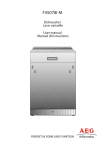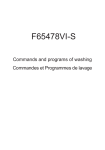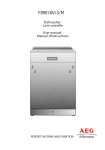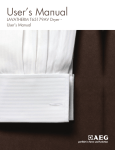Download AEG FAVORIT F89078VI-M User`s manual
Transcript
User’s Manual FAVORIT F89078VI-M 24” Stainless Steel Dishwasher User’s Manual EN CONTENTS Contents 1 INTRODUCTION ....................................................................................................................... 5 2 SAFETY INFORMATION .......................................................................................................... 7 3 INSTALLATION MATERIAL....................................................................................................10 3.1 Kit supplied with dishwasher (models F65478VI-S / F89078VI-S) .........................11 4 DIMENSIONS OF DISHWASHER ........................................................................................12 5 INSTALLATION AND HOOK-UP..........................................................................................13 5.1 Leveling.......................................................................................................................................14 5.1.1 Mounting the feet (only for some models) ....................................................................14 5.1.2 Levelling the appliance .........................................................................................................15 5.2 Connections ..............................................................................................................................16 5.2.1 Connecting to the water supply ........................................................................................17 5.2.1.1 Connecting to the water tap ...............................................................................................18 5.2.1.2 Connecting the drain hose ..................................................................................................20 5.2.2 Electrical connections and warnings ...............................................................................25 5.3 Commissioning ........................................................................................................................26 5.3.1 Installation procedure (all models) ...................................................................................26 5.3.2 Procedure for mounting the door panel ............................................................................28 5.3.3 Completion of installation........................................................................................................32 5.4 Testing .........................................................................................................................................35 Rev 0.0 3 EN INTRODUCTION 1 INTRODUCTION Thank you for choosing one of our products. To install this dishwasher correctly and safely, please read this manual carefully. The manual is divided into sections giving you a step-by-step guide to installation of the appliance. The texts are easy to understand and are complete with detailed illustrations. This user-friendly manual will provide answers to all your questions about installation of the dishwasher. This manual comprises the following sections: INTRODUCTION: general information about the manual. WARNINGS: a list of warnings concerning safety during installation. INSTALLATION INSTRUCTIONS: for the qualified technician who must carry out the installation, hook-up and testing of the appliance. Nomenclature of figures and tables: The progressive number of each figure is shown in the bottom right-hand corner of the relative box. An example of a progressive number is “Fig. 4-01”, where the first number (4) indicates the section to which the figure belongs, while the second number (01) indicates the progressive number of the figure in section 4 (Fig. 4-01 is the first figure in section 4). The tables are numbered in the same way, bearing in mind that “Tab.” is used instead of “Fig.” (e.g.: Tab. 4-01 is the first table in section 4). If a table occupies more than one page, a letter is added after the progressive number (e.g.: “Tab. 4-01a”, Tab. 4-01b”). Rev 0.0 5 EN INTRODUCTION Symbols used in this manual (see tab. 1-01) DANGER. This symbol highlights information and warnings which, if not observed, may compromise personal safety or damage the appliance. DANGER OF ELECTROCUTION. This symbol highlights information and warnings of an electrical nature which, if not observed, may compromise personal safety or damage the appliance. This symbol highlights general information and warnings. Tab. 1-01 6 Rev 0.0 EN WARNINGS 2 SAFETY INFORMATION THIS MANUAL FORMS AN INTEGRAL PART OF THE APPLIANCE AND MUST THEREFORE BE KEPT INTACT TOGETHER WITH THE MACHINE. BEFORE USING THE APPLIANCE, CAREFULLY READ ALL THE INSTRUCTIONS CONTAINED IN THIS MANUAL. INSTALLATION MUST BE PERFORMED BY A QUALIFIED TECHNICIAN, IN COMPLIANCE WITH THE REGULATIONS IN FORCE. THIS APPLIANCE IS INTENDED FOR DOMESTIC USE, AND COMPLIES WITH THE DIRECTIVES CURRENTLY IN FORCE, INCLUDING THE PREVENTION AND ELIMINATION OF RADIO FREQUENCY INTERFERENCE. THE APPLIANCE IS DESIGNED FOR THE FOLLOWING PURPOSE: WASHING AND DRYING OF DISHES; ANY OTHER USE SHALL BE CONSIDERED IMPROPER. THE MANUFACTURER DECLINES ALL RESPONSIBILITY FOR USES OTHER THAN THOSE DESCRIBED ABOVE. INSTALLATION, REPAIRS AND SERVICING MUST BE PERFORMED BY QUALIFIED AND AUTHORIZED TECHNICIANS. AS WELL AS INVALIDATING THE WARRANTY, WORK CARRIED OUT BY UNAUTHORIZED PERSONS MAY GENERATE HAZARDS. INSTALLATION MUST BE PERFORMED IN COMPLIANCE WITH ALL THE DIRECTIVES IN FORCE IN THE COUNTRY OF INSTALLATION AND, IF THESE DO NOT EXIST: IN THE UNITED STATES THE NATIONAL ELECTRIC CODE; IN CANADA THE CANADIAN ELECTRIC CODE C22.1 - LATEST EDITION/PROVINCIAL AND MUNICIPAL CODES AND/OR LOCAL CODES. THE NAME PLATE FEATURING THE TECHNICAL DATA, SERIAL NUMBER AND MARKINGS IS VISIBLY POSITIONED ON THE INNER EDGE OF THE DOOR. THE NAMEPLATE ON THE INNER EDGE OF THE DOOR MUST NEVER BE REMOVED. THIS APPLIANCE IS NOT SUITABLE FOR USE ON BOATS, CARAVANS OR THE LIKE. DISHWASHERS CERTIFIED FOR DOMESTIC USE ARE NOT SUITABLE FOR AUTHORISED FOOD FACTORIES. CHECK THAT THE VOLTAGE, FREQUENCY AND PROTECTION OF THE DOMESTIC MAINS POWER SUPPLY MATCH THE RATINGS ON THE NAME PLATE OF THE APPLIANCE. Rev 0.0 7 EN WARNINGS TWO PEOPLE WEARING SAFETY GLOVES ARE REQUIRED TO LIFT THE DISHWASHER. DO NOT LEAVING DISCARDED PACKAGING MATERIALS UNSUPERVISED WITHIN THE HOME. SEPARATE THE VARIOUS PACKAGING MATERIALS AND TAKE THEM TO THE NEAREST SORTED WASTE COLLECTION CENTRE. KEEP CHILDREN, PHYSICALLY AND/OR MENTALLY IMPAIRED ADULTS, AND ANIMALS AWAY FROM PACKAGING WASTE; DANGER OF SUFFOCATION. BEFORE PROCEEDING WITH INSTALLATION, DISCONNECT THE MAINS POWER SUPPLY FROM THE WORK AREA. DURING INSTALLATION, TAKE CARE NOT TO INJURE YOURSELF ON THE SHARP EDGES OF THE APPLIANCE; WEAR SAFETY GLOVES. THE APPLIANCE MUST BE PROVIDED WITH A GROUND CONNECTION IN ACCORDANCE WITH THE ELECTRICAL SAFETY REGULATIONS IN FORCE. IF IN DOUBT, HAVE THE SYSTEM CHECKED BY A QUALIFIED ELECTRICIAN. THE MANUFACTURER DECLINES ALL RESPONSIBILITY FOR DAMAGE TO PERSONS OR PROPERTY RESULTING FROM THE FAILURE TO GROUND THE APPLIANCE OR FROM A DEFECTIVE GROUND CONNECTION. DO NOT USE APPLIANCES WHICH HAVE BEEN DAMAGED DURING TRANSIT! IF IN DOUBT, CONSULT YOUR DEALER. THE APPLIANCE MUST BE INSTALLED AND CONNECTED IN ACCORDANCE WITH THE INSTRUCTIONS PROVIDED BY THE MANUFACTURER OR BY A QUALIFIED TECHNICIAN. DO NOT OPERATE THE DISHWASHER UNLESS ALL THE OUTER PANELS HAVE BEEN POSITIONED CORRECTLY. IMMEDIATELY AFTER INSTALLATION, BRIEFLY TEST THE APPLIANCE FOLLOWING THE INSTRUCTIONS INDICATED BELOW. IF THE DISHWASHER FAILS TO OPERATE CORRECTLY, DISCONNECT IT FROM THE ELECTRICAL POWER SUPPLY AND CALL THE NEAREST TECHNICAL SERVICE CENTRE. DO NOT ATTEMPT TO REPAIR THE APPLIANCE. 8 Rev 0.0 EN WARNINGS DO NOT USE EXTENSION CORDS, ADAPTORS OR SHUNT CONNECTIONS IN ORDER TO AVOID THE POSSIBILITY OF OVERHEATING OR BURNING, WITH CONSEQUENT FIRE HAZARD. THE MANUFACTURER DECLINES ALL RESPONSIBILITY FOR DAMAGE TO PERSONS, ANIMALS OR PROPERTY RESULTING FROM FAILURE TO OBSERVE THE ABOVE PRECAUTIONS, FROM TAMPERING WITH EVEN A SINGLE COMPONENT OF THE APPLIANCE, OR FROM THE USE OF UNORIGINAL SPARE PARTS. IF IN DOUBT ABOUT THE CONTENTS OF THIS MANUAL, CONTACT THE TECHNICAL ASSISTANCE SERVICE. Rev 0.0 9 EN INSTALLATION INSTRUCTIONS 3 INSTALLATION MATERIAL To install the dishwasher correctly, the following materials are required: • Phillips screwdriver (ref. A fig. 3-01); • spirit level (ref. B fig. 3-01); • tape measure (ref. C fig. 3-01); • compass saw (ref. D fig. 3-01); • pencil (ref. E fig. 3-01); • file (ref. F fig. 3-01); • 13 mm open-ended wrench (ref. G fig. 3-01); • plumbing pliers (ref. H fig. 3-01); • drill (ref. I fig. 3-01); • safety gloves (ref. L fig. 3-01). B A D C F E H G I L Fig. 3-01 10 Rev 0.0 EN INSTALLATION INSTRUCTIONS 3.1 Kit supplied with dishwasher (models F65478VI-S / F89078VI-S) The kit supplied with the dishwasher comprises: • adhesive steam guard (ref. A fig. 3-02); • 1 steel steam guard (ref. B fig. 3-02);* • 1 template for door panel (ref. C fig. 3-02); • 2 hooks for door panel (ref. D fig. 3-02); • 8 screws for securing the door panel hooks (ref. E fig. 3-02); • 2 screws for securing the door (ref. F fig. 3-02); • 2 screws for fixing the dishwasher to the adjacent walls (ref. G fig. 3-02); • 2 screw caps (ref. H fig. 3-02). • 2 nuts (only for some models) (ref. I fig. 3-02); • 2 washers (only for some models) (ref. L fig. 3-02); • 2 adjustment feet (only for some models) (ref. M fig. 3-02). • 2 door spacers (only for certain models) (ref. N fig. 3-02) A B D C E F G H L I M N Fig. 3-02 * The adhesive protection is suitable for kitchens with worktops that do not allow the steel protection to be fixed with screws (e.g.:+ marble or masonry), but it can be also used with other materials. Rev 0.0 11 EN INSTALLATION INSTRUCTIONS 4 DIMENSIONS OF DISHWASHER (See fig. 4-01) Model F89078VI-M F89078VI-S F65478VI-S F45078I-M A (height) B (width) C (depth) 86 cm ÷ 91 cm 33-55/64” ÷ 35-55/64” 86 cm ÷ 91 cm 33-55/64” ÷ 35-55/64” 82 cm ÷ 87 cm 32-9/32” ÷ 34-1/4” 86 cm ÷ 91 cm 33-55/64” ÷ 35-55/64” 59.7 cm ÷ 59,9 cm 23-1/2” ÷ 23-37/64” 59.7 cm ÷ 59.9 cm 23-1/2” ÷ 23-37/64” 44.7 cm ÷ 44.9 cm 17-19/32” ÷ 17-43/64” 59.7 cm ÷ 59.9 cm 23-1/2” ÷ 23-37/64” 57 cm 22-7/16” 55 cm 21-21/32” 55 cm 21-21/32” 60 cm 23-5/8” Tab. 4-01 A C B Fig. 4-01 12 Rev 0.0 EN INSTALLATION INSTRUCTIONS 5 INSTALLATION AND HOOK-UP DURING INSTALLATION, TAKE CARE NOT TO INJURE YOURSELF ON THE SHARP EDGES OF THE APPLIANCE. Remove the polystyrene rack blocks. Position the appliance in the chosen installation position. The sides and rear of the appliance can lie against kitchen units or walls. If the dishwasher is installed next to a heat source, separate it with a heat insulating panel in order to prevent overheating and malfunctions. To assure stability, only install built-in appliances under continuous worktops, securing them to the adjacent kitchen units or worktop with screws. BUILDING-IN A DISHWASHER UNDERNEATH A CERAMIC HOB IS ABSOLUTELY FORBIDDEN. A DISHWASHER CAN BE BUILT-IN UNDERNEATH A CONVENTIONAL HOB PROVIDED THERE IS NO BREAK IN THE KITCHEN WORKTOP, AND THE DISHWASHER AND HOB ARE INSTALLED AND SECURED CORRECTLY, SO THAT NO HAZARDS ARE GENERATED. MAKE SURE THE DISHWASHER HAS BEEN CORRECTLY INSTALLED AND GROUNDED BY A QUALIFIED FITTER. THIS SAFETY REQUIREMENT MUST BE MET. IN CASE OF DOUBT, CALL IN A QUALIFIED FITTER. THE MANUFACTURER DECLINES ALL RESPONSIBILITY FOR DAMAGE TO PERSONS OR PROPERTY RESULTING FROM THE FAILURE TO GROUND THE APPLIANCE OR FROM A DEFECTIVE GROUND CONNECTION. BEFORE PROCEEDING WITH INSTALLATION, DISCONNECT THE MAINS POWER SUPPLY FROM THE WORK AREA. Only for free-standing models • It is strictly forbidden to mount a hob over a free-standing dishwasher. • If the appliance is not in a niche and can therefore be accessed on one side, cover the door hinge area for safety reasons (cutting hazard). Covers are available as accessories from specialized retailers or from the Technical Service Centre. • To build in the dishwasher, purchase the relative kit from specialized retailers or from the Technical Service Centre. Rev 0.0 13 EN INSTALLATION INSTRUCTIONS 5.1 Leveling 5.1.1 Mounting the feet (only for some models) Turn the appliance upside-down (see fig. 5-01). Tighten the nut (see ref. A fig. 5-01) onto the threaded pin (see ref. B fig. 5-01) of the foot and then fit the supplied washer; do this on both feet. Screw the feet onto the appliance until the washers touch the base; the two feet must be manually adjusted to the same height to prevent excessive differences in height between one foot and the other. Put the appliance back on its feet. TWO PEOPLE WEARING SAFETY GLOVES ARE NEEDED TO TURN THE DISHWASHER UPSIDE-DOWN. A B Fig. 5-01 14 Rev 0.0 EN INSTALLATION INSTRUCTIONS 5.1.2 Levelling the appliance Level the appliance using the relative adjustable feet (e.g.: ref. A fig. 5-02); use an open-ended wrench to rotate the feet until the dishwasher is perfectly level. Some models are fitted with just one rear foot which can be adjusted with a screw located at the bottom front of the appliance (ref. A fig. 5-03); use a suitable Phillips screwdriver to turn the screw until the dishwasher is perfectly level. Use a spirit level to check the appliance is perfectly level (ref. B fig. 5-02). Leveling is vital for assuring correct dishwasher operation. Make sure to leave a gap of at least 3 mm (7/64”) between the top of the dishwasher and the worktop (ref. C fig. 5-02). Fig. 5-02 Rev 0.0 15 EN INSTALLATION INSTRUCTIONS A Fig. 5-03 5.2 Connections Install the dishwasher so as to allow ease of access to the electrical and hydraulic connections through the adjacent unit. These connections must never be behind the dishwasher. The inlet and drain hoses can be pointed in all directions. make sure that they are not bent, crushed or too tight. Tighten the ring nut after pointing the hoses in the required direction. Figure 5-04 indicates the distances to maintain between the dishwasher and the various connections. FIRE HAZARD! DO NOT COVER OR CRUSH THE CORD PLUG. A D B C A = 1200 mm / 47” B = 1500 mm / 59” C = 1600 mm / 63” D = min. 400 mm / 16” 16 Fig. 5-04 Rev 0.0 EN INSTALLATION INSTRUCTIONS A through hole with a diameter of at least 8 cm (5/32”) is required to pass the hoses and power cord (ref. A fig. 5-05). Make sure there area no rough edges that could damage the power cord or hoses. If the dishwasher is installed in a metal unit protect the edge of the through hole for the hoses and power cord with a gasket. Do not use extension cords when making the electrical connection as these do not guarantee safety. ATTENTION! INSTALLING THE DISHWASHER IN A NARROW SPACE MAY BEND OR CRUSH THE POWER CORD. TAKE GREAT CARE IN ORDER TO REDUCE THE POSSIBILITY OF DAMAGING THE POWER CORD WHEN INSTALLING OR REMOVING THE APPLIANCE. A Fig. 5-05 5.2.1 Connecting to the water supply PREVENTING THE RISK OF CLOGGING OR DAMAGE: IF THE WATER PIPE IS NEW OR HAS NOT BEEN USED FOR A LONG TIME, BEFORE CONNECTING TO THE WATER SUPPLY CHECK THAT THE WATER IS CLEAR AND FREE OF IMPURITIES, TO PREVENT DAMAGE TO THE APPLIANCE. THE DISHWASHER MUST ALWAYS BE CONNECTED TO THE WATER SYSTEM WITH NEW HOSES; OLD OR USED HOSES MUST NEVER BE REUSED. Rev 0.0 17 EN INSTALLATION INSTRUCTIONS 5.2.1.1 Connecting to the water tap Connect the inlet hose to a threaded ¾” gas cold water tap, fitting the supplied filter (ref. A fig. 5-06). Firmly secure the hose by tightening the relative ring nut with your hands (ref. B fig. 5-06); finish by tightening another ¼ turn using a pair of plumbing pliers. For models fitted with ACQUASTOP (ref. C fig. 5-06) the filter is already present in the threaded ring nut. The dishwasher can be filled with water at a temperature of less than 60°C (140°F). If the appliance is filled with hot water, washing times will be reduced by about 20 minutes, but efficiency will be slightly impaired. Make the connection to the domestic hot water tap using the same methods described for connecting the appliance to the cold water tap. • Recommended temperature: 49°C (120°F), max. 60°C (140°F). • Recommended water pressure: 0.5 - 9 bar (7 -130 PSI). If the pressure is too high, fit a pressure reducer. A rubber hose connected to a sink spray may burst if installed on the same pipes feeding the dishwasher. If your sink is fitted with this accessory, remove the hose and plug the hole. Fig. 5-06 18 Rev 0.0 EN INSTALLATION INSTRUCTIONS Do not cut the inlet hose (see fig. 5-07). If the hose is cut, the dishwasher will not work, water will leak and you may be injured. If the hose is too long, wind it up tidily and place it behind the appliance. The cable harness and electrical components must not come into contact with the hydraulic system and the water inlet and drain hoses. Fig. 5-07 When connecting the dishwasher drain hose to the sink make sure that the hose is not bent (ref. A fig. 5-08) in order to prevent cracks or breakages that could damage it. A Fig. 5-08 Rev 0.0 19 EN INSTALLATION INSTRUCTIONS 5.2.1.2 Connecting the drain hose Connecting to a drain Insert the relative hose into a drain with a minimum diameter of 4 cm (1-37/64”) (ref. A fig. 5-09); alternatively, place the hose on the sink (ref. B fig. 5-09) using the supplied hose support (see fig. 5-10), but taking care to avoid obstructions or excessive curving. Make sure the hose cannot fall out. For this purpose, the hose support is fitted with a hole (ref. A fig. 5-10) which can be used to fix it to the wall or the tap with a piece of string. The free end must lie at a height ranging from of 30 to 100 cm (from of 1-7/32” to 3-59/64”) (see fig. 5-09) and must never be immerged in water. If horizontal extension hoses with a maximum length of 3m are used, position the drain hose at a maximum height of 85 cm (3-11/32”) above the floor. A min 30 cm 1-7/32” MAX 100 cm 3-59/64” B min O4 cm 1-37/64” Fig. 5-09 A Fig. 5-10 20 Rev 0.0 EN INSTALLATION INSTRUCTIONS Connecting to a “T” union of the drain circuit MAKE THE CONNECTION UPLINE FROM THE SIPHON OF THE DRAIN LINE AND AT LEAST 400 mm (15-3/4”) ABOVE THE FLOOR ON WHICH THE DISHWASHER WILL BE INSTALLED. 1. Connect the dishwasher drain hose (ref. A fig. 5-11) to the “T” union (ref. B fig. 5-11) of the drain circuit using a 38 to 50 mm (1-1/2 to 2”) screw clamp* (ref. C fig. 5-11); if necessary, cut the end of the dishwasher drain hose (ref. D fig. 5-11) (do not cut the corrugated section). * Available from any plumbing stockist B C D A Fig. 5-11 Rev 0.0 21 EN INSTALLATION INSTRUCTIONS Connecting to a waste disposal unit with an air gap MAKE THE CONNECTION UPLINE FROM THE SIPHON OF THE DRAIN LINE AND AT LEAST 400 mm (15-3/4”) ABOVE THE FLOOR ON WHICH THE DISHWASHER WILL BE INSTALLED. 1. Remove the cover of the waste disposal unit (ref. A fig. 5-12). 2. Connect the dishwasher drain hose (ref. B fig. 5-12) to the air gap (ref. C fig. 5-12) using the wide spring clamp (ref. D fig. 5-12); if necessary, cut the end of the dishwasher drain hose (ref. E fig. 5-12) (do not cut the corrugated section). If the drain hose has been cut, use a 38 to 50 mm (1-1/2 to 2”) screw clamp*. 3. To connect the air gap (ref. C fig. 5-12) to the waste disposal unit inlet (ref. F fig. 5-12), use a rubber union* (ref. G fig. 5-12) with spring or screw clamps* (ref. H fig. 5-12). * Available from any plumbing stockist C A D H G H E B Fig. 5-12 22 Rev 0.0 EN INSTALLATION INSTRUCTIONS Connecting to the air gap (no waste disposal unit) MAKE THE CONNECTION UPLINE FROM THE SIPHON OF THE DRAIN LINE AND AT LEAST 400 mm (15-3/4”) ABOVE THE FLOOR ON WHICH THE DISHWASHER WILL BE INSTALLED. 1. Connect the dishwasher drain hose (ref. A fig. 5-13) to the air gap (ref. B fig. 5-13) using the wide spring clamp (ref. C fig. 5-13); if necessary, cut the end of the dishwasher drain hose (ref. D fig. 5-13) (do not cut the corrugated section). If the drain hose has been cut, use a 38 to 50 mm (1-1/2 to 2”) screw clamp*. 2. To connect the air gap (ref. B fig. 5-13) to the “T” union (ref. E fig. 5-13) of the drain line, use a rubber union* (ref. F fig. 5-13) with spring or screw clamps* (ref. G fig. 5-13). * Available from any plumbing stockist B C G F E D A G Fig. 5-13 Rev 0.0 23 EN INSTALLATION INSTRUCTIONS Connecting to a waste disposal unit (no air gap) MAKE THE CONNECTION UPLINE FROM THE SIPHON OF THE DRAIN LINE AND AT LEAST 400 mm (15-3/4”) ABOVE THE FLOOR ON WHICH THE DISHWASHER WILL BE INSTALLED. 1. Remove the cover of the waste disposal unit (ref. A fig. 5-14). 2. Connect the dishwasher drain hose (ref. B fig. 5-14) to the waste disposal unit inlet (ref. C fig. 5-14), using the wide spring clamp (ref. D fig. 5-14). A D C B Fig. 5-14 24 Rev 0.0 EN INSTALLATION INSTRUCTIONS 5.2.2 Electrical connections and warnings CHECK THAT THE VOLTAGE AND THE FREQUENCY OF THE MAINS MATCH THE RATINGS ON THE NAME PLATE OF THE APPLIANCE POSITIONED ON THE INNER EDGE OF THE DOOR. IN THE EVENT OF DAMAGE TO THE SUPPLY CORD, HAVE IT REPLACED BY THE MANUFACTURER OR AN AUTHORIZED TECHNICAL SERVICE CENTRE. THIS APPLIANCE MUST BE GROUNDED. IN CASE OF A MALFUNCTION OF FAULT, THE GROUND REDUCES THE RISK OF ELECTROCUTION BY PROVIDING THE ELECTRICAL CURRENT WITH AN ALTERNATIVE, LESS RESISTANT PATH. THIS APPLIANCE MUST BE GROUNDED. IN CASE OF A MALFUNCTION OF FAULT, THE GROUND REDUCES THE RISK OF ELECTROCUTION BY PROVIDING THE ELECTRICAL CURRENT WITH AN ALTERNATIVE, LESS RESISTANT PATH. THIS APPLIANCE IS FITTED WITH A SUPPLY CORD CONTAINING A GROUND WIRE AND PLUG. FIT THE PLUG INTO A SUITABLE SOCKET, INSTALLED AND GROUNDED IN COMPLIANCE WITH THE LAWS IN FORCE IN THE COUNTRY OF INSTALLATION. BEFORE MAKING ELECTRICAL CONNECTIONS, DISCONNECT THE MAINS POWER SUPPLY FROM THE WORK AREA. Grounding instructions This appliance is fitted with a cord with ground wire and plug. Fit the plug into a suitable socket, installed and grounded in compliance with the laws in force in the country of installation. CHECK THAT THE MAINS SUPPLY IN THE PLACE OF INSTALLATION COMPLIES WITH THE REGULATIONS IN FORCE IN THE COUNTRY OF USE, AND THAT IT IS CORRECTLY GROUNDED. AN INCORRECTLY CONNECTED GROUND WIRE MAY GENERATE THE RISK OF ELECTROCUTION. IF IN DOUBT AS TO THE CORRECT GROUNDING OF THE APPLIANCE, CALL IN A QUALIFIED ELECTRICIAN OR THE TECHNICAL ASSISTANCE SERVICE. DO NOT CHANGE THE PLUG ATTACHED TO THE APPLIANCE. IF THE PLUG IS NOT SUITABLE FOR THE SOCKET, CALL IN A QUALIFIED ELECTRICIAN TO FIT A SUITABLE PLUG. Rev 0.0 25 EN INSTALLATION INSTRUCTIONS The plug at the end of the power cord and the corresponding socket must be of the same type and must conform to current regulations governing electrical appliances. The plug must be accessible after installation. Never remove the plug by pulling on the wire. If the power cord is damaged, have it replaced by the manufacturer or an authorized service centre. DO NOT USE EXTENSION CORDS, ADAPTORS OR SHUNT CONNECTIONS IN ORDER TO AVOID THE POSSIBILITY OF OVERHEATING OR BURNING, WITH CONSEQUENT FIRE HAZARD. IN THE EVENT OF DAMAGE TO THE SUPPLY CORD, HAVE IT REPLACED BY THE MANUFACTURER OR AN AUTHORIZED TECHNICAL SERVICE CENTRE IN ORDER TO AVOID ANY RISK. 5.3 Commissioning 5.3.1 Installation procedure (all models) Clean the underneath of the worktop lying over the dishwasher door (see fig. 5-15) and apply the steam guard, as shown in fig. 5-16 (see fig. 5-16 if the adhesive guard is applied; see fig. 5-17 if the steel guard is applied). This guard protects the worktop from steam and condensation when the door of the dishwasher is opened at the end of the washing cycle. Fig. 5-15 26 Rev 0.0 EN INSTALLATION INSTRUCTIONS Fig. 5-16 Fig. 5-17 Push the dishwasher into position, taking care not to twist or crush the power cord or hoses (see fig. 5-18). TWO PEOPLE WEARING SAFETY GLOVES ARE NEEDED TO PUSH THE DISHWASHER INTO PLACE. Fig. 5-18 Rev 0.0 27 EN INSTALLATION INSTRUCTIONS 5.3.2 Procedure for mounting the door panel Mount the door panel. Place the template on the inner surface of the panel, centering it along the upper side and matching up the reference locators (ref. A fig. 5-19); mark the position of the door hooks with a pencil (see fig. 5-19). Remove the template and use a drill with a suitable bit to make holes at the points marked on the panel. A A Fig. 5-19 Use the screwdriver to secure the door hooks with the 8 supplied screws (see fig. 5-20) at the marked reference points. Fig. 5-20 28 Rev 0.0 EN INSTALLATION INSTRUCTIONS Drill holes for the panel handle using a drill with a suitable bit. Use the screwdriver to secure the door handle before hooking the panel to the dishwasher (see fig. 5-21). N.B.: the screws are not supplied. Fig. 5-21 Insert the door spacers contained in the accessory bag (see fig. 5-22). 2 x (s x-dx) Fig. 5-22 Rev 0.0 29 EN INSTALLATION INSTRUCTIONS Attach the door panel: fit the hooks into their slots on the dishwasher and allow the panel to slide downwards and slip in to place (see fig. 5-23). 1 2 Fig. 5-23 Secure the door to the panel with the supplied screws. The panel must have a minimum thickness of 20 mm (25/32”) (see fig. 5-24). Fig. 5-24 30 Rev 0.0 EN INSTALLATION INSTRUCTIONS Make sure the dishwasher door, complete with panel, opens comfortably and that the base plate (ref. A fig. 5-25) does not prevent it from opening fully. If the base plate prevents the door from opening, mark out the section to remove (see fig. 5-25), take out the base plate and cut it along the marking using a compass saw (see fig. 5-26). 600 mm (2 450 mm 3-53/64") (23/32 ") A Fig. 5-25 Fig. 5-26 Rev 0.0 31 EN INSTALLATION INSTRUCTIONS 5.3.3 Completion of installation Finish the cut with a file (see fig. 5-27) in order to remove any burrs and/or imperfections. Put back the base plate (see fig. 5-28) and try to open the dishwasher door fully; if the base plate still obstructs the door, repeat the above operations. Fig. 5-27 Fig. 5-28 32 Rev 0.0 EN INSTALLATION INSTRUCTIONS Before securing the dishwasher to the adjacent units, attach the gaskets to the sides. Remove the adhesive band on the gasket (see fig. 5-29). Fig. 5-29 Fix the gasket to the dishwasher, inserting it in the seat on the sides towards the front (see fig. 5-30), and making sure that the long side of the gasket, the one with the hole for inserting the screw, is attached to the outside of the dishwasher; the hole in the long side must match the hole in the dishwasher (see ref. A fig. 5-31). Make sure the gasket adheres perfectly to the dishwasher. Fig. 5-30 Rev 0.0 33 EN INSTALLATION INSTRUCTIONS A Fig. 5-31 Fig. 5-32 shows the state of the dishwasher after the above operations are performed. Fig. 5-32 34 Rev 0.0 EN INSTALLATION INSTRUCTIONS Tighten the supplied screws with a screwdriver; this operation definitively fixes the dishwasher to the adjacent units; cover the side holes using the supplied plugs (ref. A fig. 5-33). A Fig. 5-33 5.4 Testing After installation, test the dishwasher by starting a work cycle. Check for leaks and make sure the appliance does not malfunction. Rev 0.0 35 Q- Warranty AEG products are designed and built to the highest standards. We expect your appliances to provide many years of trouble free enjoyment. In the event of an appliance requiring attention, each appliance is covered by a 2 year warranty from the date of purchase. Refer to warranty policy for complete terms and conditions. Coverage is for costs of parts and labor for appliances in capital cities & metropolitan areas. We reserve the right to charge directly for handling expenses outside the metropolitan region. AEG products are supported by a national service support system. Call our customer service department for attention. Please retain your invoice AEG to quote should you require service assistance. This will identify your product for our priority service back-up. Please attach your invoice to this manual for easy future reference. AEG Canada 871 Cranberry Court Oakville, Ontario L6L 6J7 Canada Tel 905-829.3980 Fax 905-829.3985 email [email protected] For Service & Spares: EURO-PARTS 1.800.678.8352 Important: Please record details of your purchase below and mail or fax to AEG -----------------------------------------------------------------------------------------cut along line ------------------------------------------------------------------------------------ Name: Address: City : Where purchased: Items Serial No. (s): TEL No State: Zip Code: Purchase date: purchased: 33 AEG appliances are imported and distributed in North America by Euro-Line Appliances Inc. For more information visit www.euro-line-appliances.com / www.elawest.com 871 Cranberry Court Oakville, ON L6L 6J7 Canada Toll Free: 1.800.421.6332 Showroom: 905.829.3980 [email protected] 2912 West 4th Ave Vancouver, BC V6K 1R2 Canada Toll Free: 1.855.352-9378 Showroom: 604.235.3980 [email protected]












































